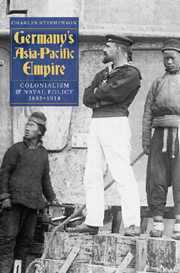Book contents
- Frontmatter
- Contents
- List of Illustrations
- List of Maps and Tables
- Introduction
- 1 Bismarck and Empire: 1885–1888. Kaiser Wilhelm's Land, the Bismarck Archipelago, the Marshall Islands and Nauru
- 2 The Acquisition of Kiautschou: 1897
- 3 China 1897–1914: Colonial Development and Political Turbulence
- 4 Tectonic Shift 1: 1898–1899. Spain and the USA, Germany, Micronesia and Samoa
- 5 Tectonic Shift 2: 1902–1914. Japan and Russia, Britain and Dominion Defence, the United States
- 6 War. August 1914
- 7 Naval Plans and Operations 1897–1914
- 8 Kiautschou: Naval and Military Operations 22 August–28 September 1914
- 9 Tsingtau: Naval and Military Operations 28 September–7 November 1914
- 10 Aftermath
- Notes to the Text
- Bibliography
- Index
4 - Tectonic Shift 1: 1898–1899. Spain and the USA, Germany, Micronesia and Samoa
Published online by Cambridge University Press: 12 September 2012
- Frontmatter
- Contents
- List of Illustrations
- List of Maps and Tables
- Introduction
- 1 Bismarck and Empire: 1885–1888. Kaiser Wilhelm's Land, the Bismarck Archipelago, the Marshall Islands and Nauru
- 2 The Acquisition of Kiautschou: 1897
- 3 China 1897–1914: Colonial Development and Political Turbulence
- 4 Tectonic Shift 1: 1898–1899. Spain and the USA, Germany, Micronesia and Samoa
- 5 Tectonic Shift 2: 1902–1914. Japan and Russia, Britain and Dominion Defence, the United States
- 6 War. August 1914
- 7 Naval Plans and Operations 1897–1914
- 8 Kiautschou: Naval and Military Operations 22 August–28 September 1914
- 9 Tsingtau: Naval and Military Operations 28 September–7 November 1914
- 10 Aftermath
- Notes to the Text
- Bibliography
- Index
Summary
Kiautschou was not the last territory Germany was to obtain in the Far East, though it was to be the last acquired by force of arms, or at least at first hand. The German interest in acquiring further territory coincided with an unrelated struggle between a long established imperial power and an up and coming one; the Spanish–American War of 1898. There were several factors entering into the American decision to go to war against Spain, including the Cuban struggle for independence, American imperialism, and, the ostensible trigger, the sinking of the US battleship Maine in Havana harbour on 15 February 1898.
Spain and the US went formally to war on 25 April, and on the 27th Commodore George Dewey of the US Navy sailed from a bay near Hong Kong, in command of his seven-ship Asiatic Squadron. He had left the British territory on 24 April, having received telegraphed orders from Secretary of the Navy John Davis Long (across the International Date Line) to attack the Spanish Navy in the Philippines: ‘War has commenced between the United States and Spain. Proceed at once, particularly against Spanish fleet. You must capture vessels or destroy. Use utmost endeavors.’
Dewey's squadron arrived at the mouth of Manila Bay on the night of 30 April and he planned to enter the bay and attack whatever Spanish warships he found there the next morning.
- Type
- Chapter
- Information
- Germany's Asia-Pacific EmpireColonialism and Naval Policy, 1885–1914, pp. 49 - 66Publisher: Boydell & BrewerPrint publication year: 2009

